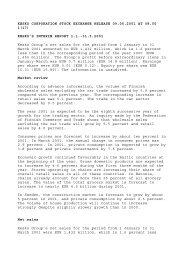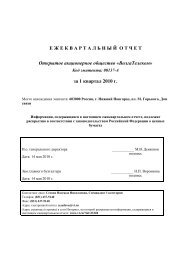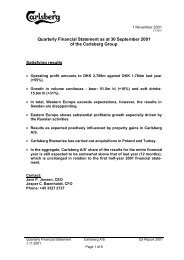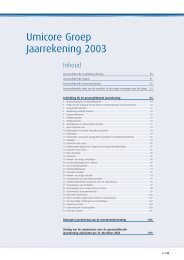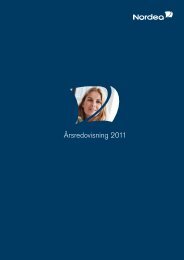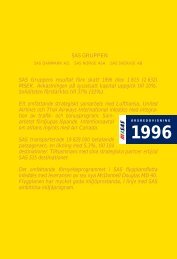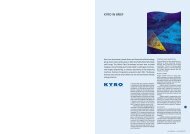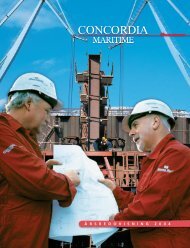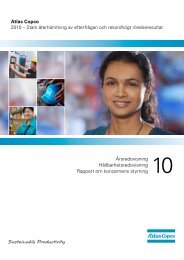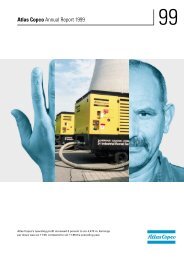össur annual report2009 - Euroland
össur annual report2009 - Euroland
össur annual report2009 - Euroland
You also want an ePaper? Increase the reach of your titles
YUMPU automatically turns print PDFs into web optimized ePapers that Google loves.
Össur hf. consolidated financial stateMents 2009<br />
combination. Cash-generating units to which goodwill has<br />
been allocated are tested for impairment <strong>annual</strong>ly, or more<br />
frequently when there is an indication that the unit may be<br />
impaired. If the recoverable amount of the cash-generating<br />
unit is less than its carrying amount, the impairment<br />
loss is allocated first to reduce the carrying amount of any<br />
goodwill allocated to the unit and then to the other assets<br />
of the unit pro-rata on the basis of the carrying amount of<br />
each asset in the unit. An impairment loss recognised for<br />
goodwill is not reversed in a subsequent period.<br />
On disposal of a subsidiary, the attributable amount of<br />
goodwill is included in the determination of the profit or<br />
loss on disposal.<br />
The Company’s policy for goodwill arising on the acquisition<br />
of an associate is described at 3.5 above.<br />
3.7 revenue recognition<br />
Revenue is measured at the fair value of the consideration<br />
received or receivable. Revenue is reduced for estimated<br />
customer returns, rebates and other similar allowances.<br />
SALE OF GOODS<br />
Revenue from the sale of goods is recognised when all<br />
the following conditions are satisfied; the Company has<br />
transferred to the buyer the significant risks and rewards<br />
of ownership of the goods, the Company retains neither<br />
continuing managerial involvement to the degree usually<br />
associated with ownership nor effective control over the<br />
goods sold, the amount of revenue can be measured reliably,<br />
it is probable that the economic benefits associated<br />
with the transaction will flow to the entity and the costs<br />
incurred or to be incurred in respect of the transaction can<br />
be measured reliably.<br />
<strong>annual</strong> report 09<br />
68<br />
ROYALTIES<br />
Royalty revenue is recognised on an accrual basis in<br />
accordance with the substance of the relevant agreement.<br />
Royalties determined on a time basis are recognised on<br />
a straight-line basis over the period of the agreement.<br />
Royalty arrangements that are based on production, sales<br />
and other measures are recognised by reference to the<br />
underlying arrangement.<br />
INTEREST INCOME<br />
Interest income is accrued on a time basis, by reference<br />
to the principal outstanding and at the effective interest<br />
rate applicable.<br />
3.8 leasing<br />
Operating lease payments are recognised as an expense<br />
on a straight-line basis over the lease term, except where<br />
another systematic basis is more representative of the<br />
time pattern in which economic benefits from the leased<br />
assets are consumed. Contingent rentals arising under<br />
operating leases are recognised as an expense in the period<br />
in which they are incurred.<br />
In the event that lease incentives are received to enter<br />
into operating leases, such incentives are recognised as a<br />
liability. The aggregate benefit of incentives is recognised<br />
as a reduction of rental expense on a straight-line basis,<br />
except where another systematic basis is more representative<br />
of the time pattern in which economic benefits from<br />
the leased assets are consumed.<br />
3.9 foreign currencies<br />
For the purpose of presenting Consolidated Financial<br />
Statements, the assets and liabilities of the Company’s<br />
foreign operations are expressed in USD using exchange<br />
rates prevailing at the balance sheet date. Income and<br />
expense items are translated at the average exchange rates<br />
for each quarter within the period, unless exchange rates<br />
fluctuated significantly during that period, in which case<br />
the exchange rates at the dates of the transactions are<br />
used. Exchange differences arising, if any, are classified<br />
as equity and transferred to the Company’s translation<br />
reserve. Gains and losses on hedging instruments that<br />
are designated as hedges of net investments in foreign<br />
operations are included in the foreign currency translation<br />
reserve. Such exchange differences are recognised in<br />
profit or loss in the period in which the foreign operation<br />
is disposed of.<br />
Exchange differences are recognised in profit or loss in the<br />
period, except exchange differences relating to hedge of a<br />
net investment in foreign operations.<br />
Goodwill and fair value adjustments arising on the acquisition<br />
of a foreign operation are treated as assets and<br />
liabilities of the foreign operation and translated at the<br />
closing rate.<br />
3.10 borroWing costs<br />
Borrowing costs directly attributable to the acquisition,<br />
construction or production of qualifying assets, which are<br />
assets that necessarily take a substantial period of time<br />
to get ready for their intended use or sale, are added to<br />
the cost of those assets, until such time as the assets are<br />
substantially ready for their intended use or sale.<br />
All other borrowing costs are recognised in profit or loss in<br />
the period in which they are incurred.



